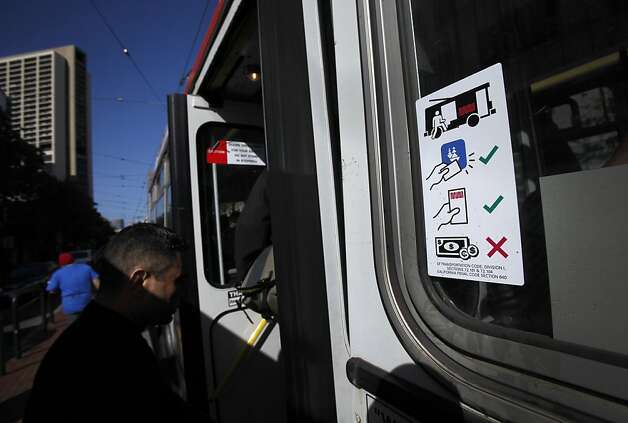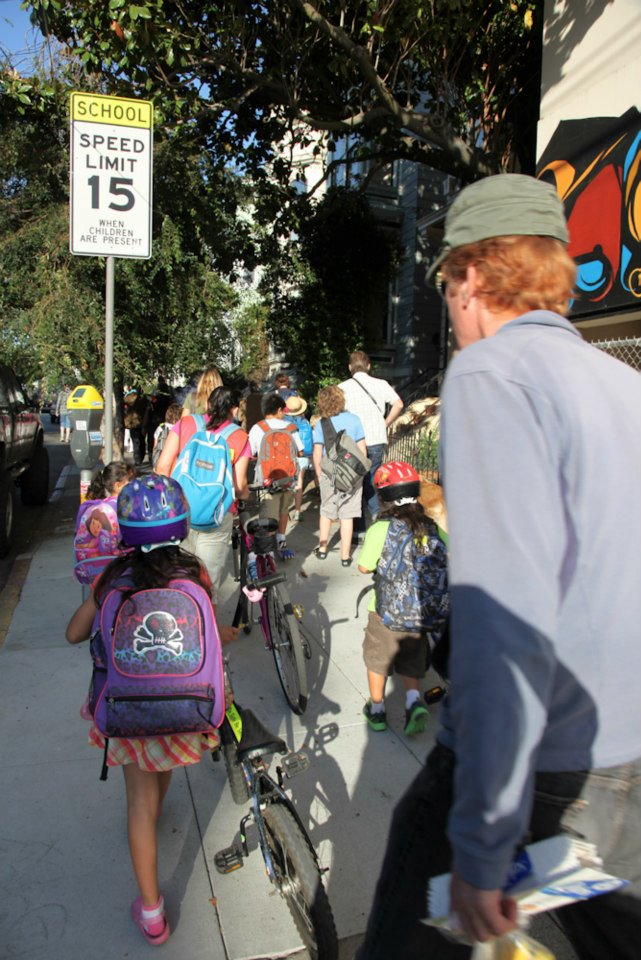Here we present Streetsblog SF's first annual Streetsie Awards to recognize the highlights of 2012. In case you missed it, check out the voting results from last week's polls in the reader's choice categories.
Today, we start with the positive, celebrating transportation improvements and leaders. We'll return with another round next week, and be back to our regular publishing schedule on January 2. Happy New Year!
P.S.: We are getting ever-so-close to reaching our year-end pledge drive goal, so if you haven't gotten around to it yet, please make a tax-deductible contribution to Streetsblog and Streetfilms and help us bring you coverage and commentary that makes a difference for safer streets and better transportation options in SF in 2013.
Best Livable Streets Story
Muni's long-overdue switch to all-door boarding was voted the year's top story with good reason: It's probably the best thing to happen for transit riders in Muni's recent history. As the SFMTA found early on, the new policy is speeding buses on one of the country's slowest transit systems, and that saves travelers time and the agency money. While it's the first policy change of its kind in the nation (other cities are watching the experiment), for many Muni riders, it simply legitimizes the practice of rear-door boarding that they've already been doing to move things along more efficiently (or to skip the fare, though inspectors are supposed to take care of that now, and fare revenue apparently hasn't dropped).
Following close behind in the "best story" category were Chinatown's successful week without car parking and San Franciscans' embrace of parklets as an institution in the city's urban fabric. Both stories helped debunk -- yet again -- the myth that re-purposing car parking space for other uses will hurt businesses.
Best Bike Improvement
It's only three blocks long, but the arrival of the Fell Street separated bike lane was huge. It's already making the Wiggle -- one of the city's most topographically important bicycling routes -- accessible to more San Franciscans. And it's no wonder the project blew the other contenders out of the water: It ended the reign of the "three blocks of terror" (in one direction, anyway) that have, for decades, scared so many would-be bike commuters away from the flattest, most direct central route between the eastern and western neighborhoods. And while 2012 started out with the frustrating news that San Franciscans would have to wait until next spring for a safer bike lane as the SFMTA turned it into a larger project (in part to replace some of the free car parking spots that would be removed), the agency did ultimately seem to make the Fell lane a priority once it was approved by the SFMTA Board, laying down the essential pieces of infrastructure within a month. City Hall followed up with strong support for safer streets, when the Board of Supervisors' unanimously rejected a meritless appeal against the project filed by a few ardent NIMBYs who threatened to delay construction already underway.
In the next few months, we can look forward to the roll-out of the parallel protected bike lane planned on Oak Street, as well as concrete planters and sidewalk bulb-outs on both streets, bike traffic signals, and slower synchronized traffic signal speeds -- all of which will bring some long-needed safety improvements to the neighborhood.
Of course, the year also brought some other notable early signs of San Francisco's Copenhagenization (term coined here), especially along what the SF Bicycle Coalition dubbed the "Bay to Beach" route in its Connecting the City campaign. At the junction of Market and Valencia, two of the city's busiest bicycling streets, the city installed a left-turn pocket and traffic signal for bikes, complete with some pretty large directional signage. It's perhaps the city's most visible adoption of the specialized bike infrastructure that's so uncommon in America, but widely used in the world's most bike-friendly cities to make cycling as intuitive as navigating a freeway junction.
Connecting Market and Fell, the Wiggle was also graced with a green bike channel at the improved Duboce and Church intersection (along with a package of goodies for pedestrians and Muni riders) and green-backed sharrows, which the SFMTA introduced as a surprise on Bike to Work Day. All the way down at the west end of the Panhandle lies SF's first parking-protected bike lane on JFK Drive, which planners and advocates have called a learning experience for similar projects in the future.
With the political momentum for protected bike infrastructure building, and the SFMTA set to unveil its promising Bicycle Strategy in January, expectations are high for an accelerated roll-out of protected bike lanes on the streets where they're needed most.
Biggest Stride Toward Kid-Friendly Streets
Streets surrounding 181 schools in San Francisco now have signs marking 15 MPH zones, telling drivers to take extra caution when motoring where lots of children roam. Those zones encompass a significant chunk of the city's streets, and SF is the first city in the state to launch such a widely-scaled program. The next step is to implement physical traffic-calming measures on those streets, and the new speed limits should make that easier under state law, which, in the fashion of backwards, 20th-century car-centric logic, can actually prohibit safety measures on streets where the speed limit is deemed too high.
Most Anticipated Transportation Improvement for Next Year
Will BART remove the rush-hour bike ban in 2013? Streetsblog readers certainly seem to hope so: The move was voted the most anticipated transportation improvement in the coming year. BART's trial run during four Fridays in August went as well as -- if not better than -- normal. It's certainly a crucial change for the agency to make if it's to meet its target of doubling bike-to-BART ridership in the next ten years (as are its plans to expand bike parking).
Two other repeatedly delayed transportation amenities were also high on readers' wish lists: Red-colored transit-only lanes on Church Street and the launch of bike-share in downtown SF and Silicon Valley. However, by the time it arrives -- next summer at the earliest -- the excitement around a bike-share system with just 1,000-bikes and 100 stations spread across five cities might have well died down. At this point, the delay will have reached at least a full year.
City Hall's Most Active Transportation Reformer
Sustainable transportation advocates may not always agree with Supervisor Scott Wiener's arguments, but he certainly deserves credit for taking more action than any of his colleagues to improve the city's transportation and land use practices. Whether it's finding ways to help bring more funding to Muni, re-working parking ordinances to expand car-share, or raising pedestrian safety issues in the political discourse, Wiener grabs the year's Streetsie for the most active politician at City Hall trying to improve transportation policy.
Wiener persistently opposed free Muni for youth in favor of funding vehicle maintenance first. Transit advocates have fallen on both sides of that fence, but Wiener's enduring stance showed that improving Muni was a top priority for him, and that he'll fight to ensure decisions benefit riders the way he sees to be most effective. And it's unfortunate that Wiener's fellow supervisors let their Muni-riding constituents down by voting against his latest attempt to boost funds for transit improvements.
Still, there's one stance of Wiener's that we can't let him off the hook for: That's his uniquely vocal opposition to enforcing parking meters on Sundays. It was sort of baffling to hear, since Weiner is the type of politico who's expected to understand that, when it goes into effect in January, the policy change will improve transportation for just about everyone -- even the vociferous churchgoing opponents who will actually have an easier time finding a nearby parking spot legally (though they'll probably still get free double parking). We'll have to hope that in the future, he doesn't bend to inflammatory rhetoric and oppose other sensible transportation improvements.
Biggest Political Victory for Transportation Reform: Sunday Parking Meters
Putting that last note on Wiener aside, we can celebrate the fact that San Francisco's parking meter enforcement schedule will no longer be stuck in 1947, when no shops were open on Sunday. When this change kicks in next month, I know I'll be keeping an eye out to see if there's a noticeable reduction in car traffic needlessly circling for parking.
Largest Demonstration for SF's Bicycle Movement... Ever?
With estimates as high as 10,000 participants, the Critical Mass 20th Anniversary ride may have been the biggest yet in the movement's city of origin. Travelers came from across the globe to take part in the celebration, and as we noted, the mostly positive public reaction represented huge progress from the early years of police crackdowns. Love it or hate it, Critical Mass has played a key role in boosting the movement for better streets for bicycling.










